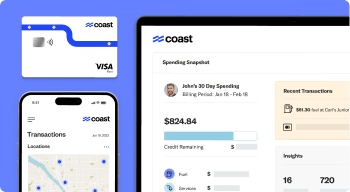A fleet manager’s job is all about knowing what’s going on with drivers and vehicles whether they’re across town or across the country. Fleet monitoring is the foundation of that activity.
But what exactly is fleet monitoring, why is it so important, and how can you make your fleet monitoring program more effective? You’ll learn the answers to those questions in this article.
Why Is Fleet Monitoring Important?

Fleet monitoring is important for the success of your business because it helps you:
- Make the best use of your assets
- Control costs
- Bring order to an inherently disorganized process
With GPS and on-board diagnostic (OBD) data — collectively known as telematics — you can optimize routes, monitor driver behavior, schedule preventative and mandatory repairs, manage fuel consumption, keep up with compliance requirements, and much more.
Without the insight that the practice and technology of fleet monitoring provides, your job would be much more difficult, take up much more time, and leave you with fewer opportunities to improve the way your business works.
Tips For Effective Fleet Monitoring

At its most basic, fleet monitoring is about using vehicle data to improve the way your business operates.
Once you have the hardware installed, the software up and running, and the numbers rolling in, how can you structure your fleet monitoring activities for the best effect? And what can you do with the information to make your business run better?
1) Track Everything
The power of fleet monitoring lies in the sheer scope of data available. That’s why we recommend tracking everything possible.
Telematics software may allow you to turn off variables that you think you don’t need. But, at some point, those variables may become important for the continued safe operation of the vehicle.
Some telematics programs will even allow you to customize how you look at the data while still recording everything in the background.
For example, you may only want to keep track of tire inflation and miles per gallon right now and not have to sift through engine rpm, brake wear, speed, and distance information to get to it.
With the right software, you can separate the tire inflation and miles per gallon variables for a less cluttered view but still keep the other data coming in case you need it later.
However you choose to look at the data, continue to track everything that the hardware and software allow even though you don’t necessarily pay attention to all of it all the time.
2) Plan For The Long Term
One of the more important aspects of fleet monitoring is that it allows you to plan for the long-term operation of each vehicle.
Without the data that telematics provides, you’d have no way of knowing when a vehicle is approaching or beyond its useful life.
As a result, you’d have no way to prepare for the time when a vehicle needs to be retired or temporarily taken out of service. You’d just have to use your best judgment and react. While fleet managers did that before telematics, it wasn’t an accurate or efficient way to operate.
Some vehicles may have been retired while still having plenty of miles left in them, while other vehicles were kept on the road when they should have been taken out of service a long time ago.
Both scenarios can cause an increase in overall operating costs and make everyone’s job more difficult.
Fleet monitoring provides the numbers you need to create a long-term plan so that, when it is time to replace a vehicle, your business will be prepared and ready to make the switch.
3) Educate Your Team On How Fleet Monitoring Works

Getting the most out of your fleet monitoring program means getting everyone on the same page, familiar with the technology, and familiar with what it does.
At first, your drivers and mechanics may feel that installing telematics on company vehicles is an invasion of their privacy and shows that you don’t trust their skills, when, in fact, it can be a valuable tool for two-way communication.
That’s why it’s important to educate your team on how fleet monitoring works and why your business needs the insights to continue to grow.
Once your employees know how telematics works, what data you’re looking at, and that you’re not trying to micromanage their job, they’ll be more receptive and accepting of the new transparency.
Drivers may even find the information gained from telematics beneficial. It can help them spot patterns and behaviors they can improve upon and allow for more real-time communication when required.
4) Use Your Fleet To The Fullest
Fleet monitoring is all about getting the most out of the vehicles you have in service. That could be optimizing routes, preventing breakdowns, minimizing wear and tear, or a whole host of other variables.
One such variable that many fleet managers forget to examine is whether or not they’re using their fleet to the fullest.
For example, your business may have 10 vehicles in service but only use eight most of the time. The other two vehicles sometimes go days, or even weeks, between uses while you continue to pay the costs associated with their operation and upkeep.
Could your business get rid of one or both of those extra vehicles and operate effectively on the eight or nine that are left?
Use the data that fleet monitoring technology provides to help you answer that question and find ways to reduce costs, save money, and make your business run better.
5) Encourage Good Driving Behavior

As we mentioned earlier, fleet maintenance technology records a wide variety of data — some of which can tell you a lot about driver behavior on the road. Armed with that information, you can then take steps to help drivers improve.
For example, telematics in one delivery van reveals that driver A tends to accelerate quickly, brake hard, and negotiate corners a bit too fast for the load they’re carrying.
The same telematics in the same delivery van then reveals that driver B accelerates at a lower rate, brakes more consistently over long distances, and negotiates corners at a speed that is more in line with the load they’re carrying.
Upon further analysis, you discover that the vehicle piloted to the same destination and back uses less gas and runs at a lower temperature when driver B is behind the wheel.
That’s better for the vehicle, the fleet, and your business. And now you have the numbers to prove it.
You can use the data to encourage good driving behaviors and practices throughout your fleet. You can also use the data to eliminate negative habits that your drivers may not even be aware they have.
6) Establish Preventative Maintenance Programs
Effective fleet monitoring and effective fleet management are two sides of the same coin — they both depend on the other for continued success.
The same is true for many of the tips on this list — they’re all intimately intertwined and depend on one another for the success of the whole.
Planning for the long term, for example, wouldn’t be possible without a preventative maintenance program to back it up.
Preventative maintenance is the theory and practice of monitoring the condition of a vehicle and making necessary repairs before an issue spreads to other systems (and becomes more expensive).
The data that telematics provides helps you create a custom maintenance program for each vehicle, which, in turn, extends the useful life of that asset.
No two vehicles operate and wear the same way. The engine of one may run a bit hotter. You may need to replace the brakes of one vehicle more often. And you may have to change the oil of one vehicle after every trip.
The telematics in each vehicle will reveal the best course to take.
Without fleet monitoring and regular repair, your vehicles are more susceptible to unforeseen breakdowns and the emergency maintenance that comes with them.
One of the best things you can do for your fleet is to analyze the data and use it to establish unique preventative maintenance programs for all your vehicles.
Effective Fleet Monitoring And Operations With Coast

Telematics and GPS have made fleet monitoring easier than ever before. But the hardware you install in your vehicles can only tell you so much.
To get the full picture of how your fleet operates, you’ll need to add more layers of tracking.
Coast can help with controls and visibility that work for your business through a fleet card and expense management platform that empower you with real-time information related to your fleet.
For more information on how Coast can streamline your fleet management program, visit CoastPay.com today.


